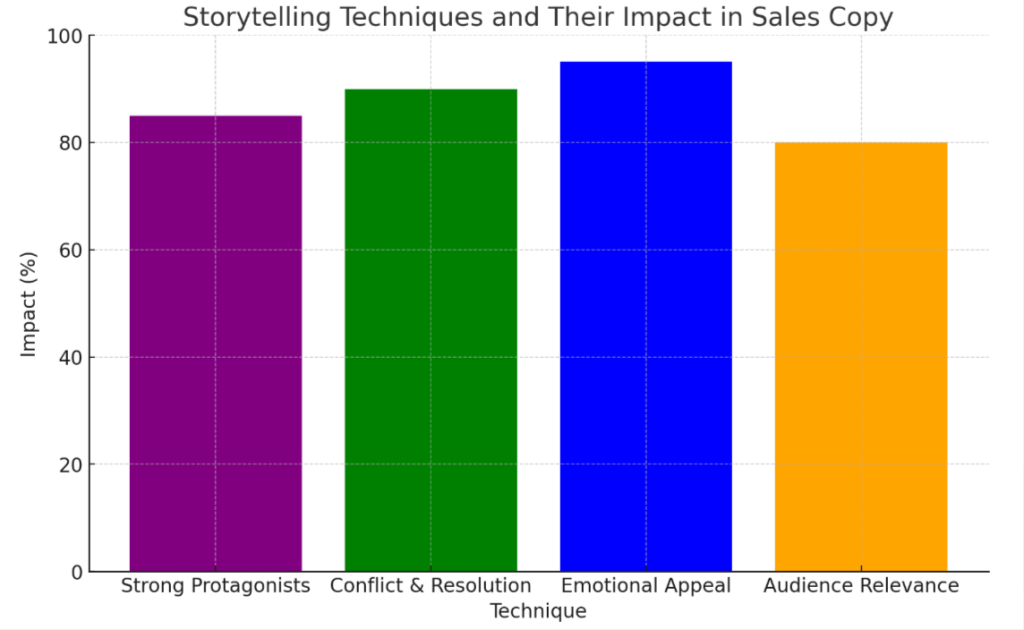Harnessing Storytelling: Transforming Sales Copy into Captivating Stories
What is Storytelling in Sales Copy?
Storytelling in sales copy refers to the use of compelling narratives and storytelling techniques to engage, persuade, and connect with potential customers. It is a powerful tool that allows marketers to create an emotional connection between their product or service and their target audience.
Definition
Storytelling in sales copy refers to the strategic use of narratives to promote a product or service. It’s a powerful tool that transforms plain information into compelling content, making it easier for potential customers to connect with the brand on an emotional level.
This technique goes beyond mere product descriptions; it weaves tales around the benefits and value propositions of your offerings. By using storytelling techniques, companies craft messages that ‘show’ rather than ‘tell’, engaging audiences more deeply and prompting them into action.
Importance in marketing
Storytelling holds a significant role in marketing due to its natural ability to capture attention and engage audiences. In the world of sales copywriting, storytelling serves as an essential tool in the copywriter’s arsenal.
Effective use of this technique can transform content from mundane details into powerful narratives that stir emotions and encourage consumers to take action. With mindblowing science backing up its effectiveness, storytelling enables marketers to deliver their messages more creatively and personally than traditional methods allow.
It promotes audience engagement by humanizing your brand or product, making it much easier for customers to connect emotionally with what you’re selling. Plus, storytelling provides specificity, which adds authenticity to campaigns while also increasing their persuasiveness through neurological triggers.
How Storytelling Can Impact Sales
Storytelling in sales copy has the power to evoke emotion, build trust and connection with customers, and differentiate businesses from their competitors.
Evokes emotion
Stories that are well-told have a profound ability to stir emotions in readers. They make us laugh, cry, get angry or feel inspired. In sales copywriting, using emotional triggers can be incredibly powerful because they compel people to take action.
The science behind this is clear: our brains are wired to respond to emotions more than logic. So, when a story makes your audience feel something strongly—whether it’s fear of missing out on a great deal or excitement about what your product can do for them—it increases the likelihood they’ll follow through with purchasing decisions.
Therefore, evoking emotion should be an integral part of any storytelling strategy in sales copywriting because of its power to drive engagement and inspire action among potential customers.
Builds trust and connection
Storytelling in sales copy is a powerful tool that can build trust and connection with your audience. By crafting compelling stories, you create an emotional bond between your brand and the customer.
When customers relate to the characters or situations in your story, they feel understood, which helps establish trust. Additionally, storytelling allows you to showcase your brand’s values and personality, making it easier for customers to connect with you on a deeper level.
This connection goes beyond just selling products; it fosters loyalty and turns customers into advocates for your brand. Whether it’s through relatable anecdotes or inspiring narratives, incorporating storytelling into your sales copy can greatly enhance engagement and build lasting relationships with your audience.
Differentiates from competitors
Storytelling in sales copy is an incredibly effective tool for setting your business apart from competitors. By crafting a compelling narrative, you create a unique brand identity that resonates with customers on a deeper level.
This emotional connection helps to differentiate you from others in the market and can ultimately lead to increased customer loyalty. When your audience feels connected to your brand through storytelling, they are more likely to choose you over competitors who lack that personal touch.
So, incorporating storytelling into your sales copy is not only a way to engage customers but also a powerful strategy for standing out from the crowd.
In addition, storytelling allows you to showcase what makes your products or services different from those of your competitors. Instead of relying solely on features and benefits, which can easily be replicated by others, storytelling enables you to communicate your unique value proposition in a way that captures attention and holds interest.
By highlighting specific examples or anecdotes that illustrate how your offering solves problems or fulfills desires better than anyone else’s, you position yourself as the superior choice.
Elements of a Good Story in Sales Copy
A good story in sales copy includes a strong protagonist, conflict and resolution, emotional appeal, and relevance to the target audience.
Strong protagonist
A strong protagonist is a key element in effective storytelling for sales copy. They are the central character that drives the narrative and engages the audience. In sales copy, a strong protagonist can be a customer who faced challenges or obstacles that your product or service helped them overcome.
By showcasing their journey, you create relatability and emotional connection with your target audience, making them more likely to resonate with your message. A compelling protagonist adds depth to your story and helps differentiate you from competitors by highlighting why your solution is unique and valuable.
Conflict and resolution
Conflict and resolution are essential elements of a good story in sales copy. The conflict creates tension and captures the audience’s attention, while the resolution provides a satisfying conclusion.
By incorporating conflict and resolution into your sales copy, you can create an engaging narrative that keeps readers hooked until the end. Whether it’s showcasing how your product solves a customer’s problem or presenting a challenge that your brand overcomes, conflict and resolution add depth to your storytelling and make your sales copy more compelling.
Emotional appeal
Emotional appeal is a powerful tool in sales copy that can deeply impact your audience. By tapping into their emotions, you create a connection and engagement that goes beyond rational decision-making.
When crafting a story for your sales copy, incorporating emotional elements such as joy, fear, or excitement can evoke strong feelings in your readers, making them more receptive to your message.
This emotional connection helps build trust and authenticity, making it easier for customers to relate to your brand and products. By appealing to the emotions of your audience, you can create a lasting impression and increase the likelihood of conversion.
Relevance to target audience
To effectively connect with your target audience, it is essential to make your sales copy relevant to them. Storytelling in sales copy allows you to do just that. By using relatable characters, situations, and emotions, you can engage your audience on a deep level.
When you share stories that mirror their experiences or aspirations, they are more likely to pay attention and connect with the message. This relevance not only captures their interest but also makes them feel understood and valued.
Incorporating storytelling into your sales copywriting arsenal helps tailor your content specifically for your audience, increasing the chances of driving engagement and ultimately boosting sales.
In addition to creating a personalized connection, storytelling in sales copy helps establish trust between you and your target audience. Through authentic narratives of challenges faced by the protagonist (your ideal customer), conflicts overcome, and resolutions reached, you demonstrate empathy and understanding.
This builds credibility as it shows that you have experience in solving similar problems or fulfilling their desires. By leveraging the emotional impact of a well-crafted story, you can differentiate yourself from competitors who may be solely focused on product features or benefits.
Tips for Incorporating Storytelling into Sales Copy
Know your audience and tailor your story to resonate with their specific needs and desires.
Know your audience
Knowing your audience is a crucial step in incorporating storytelling into your sales copy. By understanding who you are targeting, you can tailor your story to resonate with their specific needs and desires.
Consider their demographics, interests, values, and pain points. This knowledge will allow you to craft a narrative that speaks directly to them, making it more relatable and engaging.
Understanding your audience also helps you choose the right tone and language style for your story, ensuring that it resonates with them on a deeper level. So take the time to research and analyze your target demographic – knowing your audience is key to creating effective sales copy through storytelling.
Use vivid language and sensory details
Vivid language and sensory details can bring your sales copy to life, capturing the attention of your audience and creating a memorable experience. Here are some tips for incorporating these elements into your storytelling:
- Paint a picture with words: Use descriptive adjectives and verbs to create vivid mental images in the minds of your readers. For example, instead of saying “our product is effective,” you could say “our product delivers remarkable results.”
- Appeal to the senses: Engage your audience’s senses by including sensory details in your writing. Describe how something looks, feels, sounds, smells, or tastes to create a more immersive experience. This will help readers connect with your story on a deeper level.
- Show, don’t tell: Instead of simply stating facts or features about your product or service, show how it can benefit the reader through storytelling. Use scenes and dialogue to illustrate the transformation or improvement that can occur when someone uses what you’re offering.
- Use figurative language: Metaphors, similes, and other forms of figurative language can make your writing more engaging and memorable. They can also help simplify complex concepts or make them easier for readers to understand.

Use anecdotes and customer testimonials
Anecdotes and customer testimonials are powerful tools in sales copy.
Keep it concise and on-brand
Incorporating storytelling into sales copy can be a powerful tool, but it’s important to keep it concise and on-brand. By keeping your story short and to the point, you ensure that your audience stays engaged and doesn’t get lost in unnecessary details.
Additionally, staying true to your brand voice and message helps maintain consistency and credibility. Make sure every element of your story serves a purpose in driving home the main point of your sales pitch.
Remember, brevity is key when using storytelling in sales copy.
Conclusion
Storytelling in sales copy has the power to captivate and influence potential customers. By evoking emotion, building trust, and differentiating from competitors, storytelling can have a deep impact on sales.
Incorporating strong protagonists, conflict and resolution, emotional appeal, and relevance to the target audience can make your sales copy stand out and engage your readers. Don’t miss out on this powerful tool in your copywriter’s arsenal!

